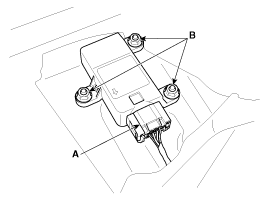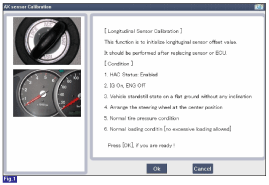 Hyundai Veloster: Yaw-rate and Lateral G Sensor. Repair procedures
Hyundai Veloster 2011-2017 Service Manual / Brake System / ESC(Electronic Stability Control) System / Yaw-rate and Lateral G Sensor. Repair procedures
Hyundai Veloster: Yaw-rate and Lateral G Sensor. Repair procedures
Hyundai Veloster 2011-2017 Service Manual / Brake System / ESC(Electronic Stability Control) System / Yaw-rate and Lateral G Sensor. Repair procedures
Hyundai Veloster 2011-2017 Service Manual / Brake System / ESC(Electronic Stability Control) System / Yaw-rate and Lateral G Sensor. Repair procedures
Removal
| 1. |
Turn ignition switch OFF and disconnect the negative (-) battery
cable.
|
| 2. |
Remove the passenger seat assembly.
(Refer to the Body group - "Seat")
|
| 3. |
Disconnect the yaw rate & lateral G sensor connector (A).
|
| 4. |
Remove the mounting bolts (B).
|
| 5. |
Installation is the reverse of removal.
|
| ■ longitudinal G sensor Calibration |
| 1. |
IG ON, ENG OFF
|
| 2. |
Stand the vehicle on a flat ground without any inclination.
|
| 3. |
Set the steering wheel at the center position.
|
| 4. |
Keep the vehicle under normal tire pressure condition and normal
loading condition.
|
| 5. |
Connect GDS to Data Link Connector(DLC).
|
| 6. |
Perform Longitudinal G Sensor Calibration.(figure 1).
|
| 7. |
Confirm success or failure of calibration.
|
 Yaw-rate and Lateral G Sensor. Description and Operation
Yaw-rate and Lateral G Sensor. Description and Operation
Description
When the vehicle is turning with respect to a vertical axis the yaw rate
sensor detects the yaw rate electronically by the vibration change of plate
fork inside the yaw rate sens ...
 ESC OFF Switch. Description and Operation
ESC OFF Switch. Description and Operation
Description
1.
The ESC OFF switch is for the user to turn off the ESC system.
2.
The ESC OFF lamp is on when ESC OFF switch is engaged.
...
See also:
Tail Gate. Repair procedures
Replacement
Tail Gate Assembly Replacement
•
When removing and installing the tail gate,
...
Components and Components Location
Components Location
1. Fuel Tank
2. Fuel Pump
3. Fuel Filter
4. Fuel Pressure Regulator
5. Canister
6. Fuel Tank Band
7. Fuel Filler Hose
8. Ventilatio ...
Description and Operation
Description
The immobilizer system will disable the vehicle unless the proper ignition
key is used, in addition to the currently available anti-theft systems such
as car alarms, the immobili ...
Categories
- Hyundai Veloster Manuals Home
- Hyundai Veloster 2010-2017 Owner's Manual
- Hyundai Veloster 2010-2017 Service Manual
© 2011-2025 Copyright www.hvmanual.com


